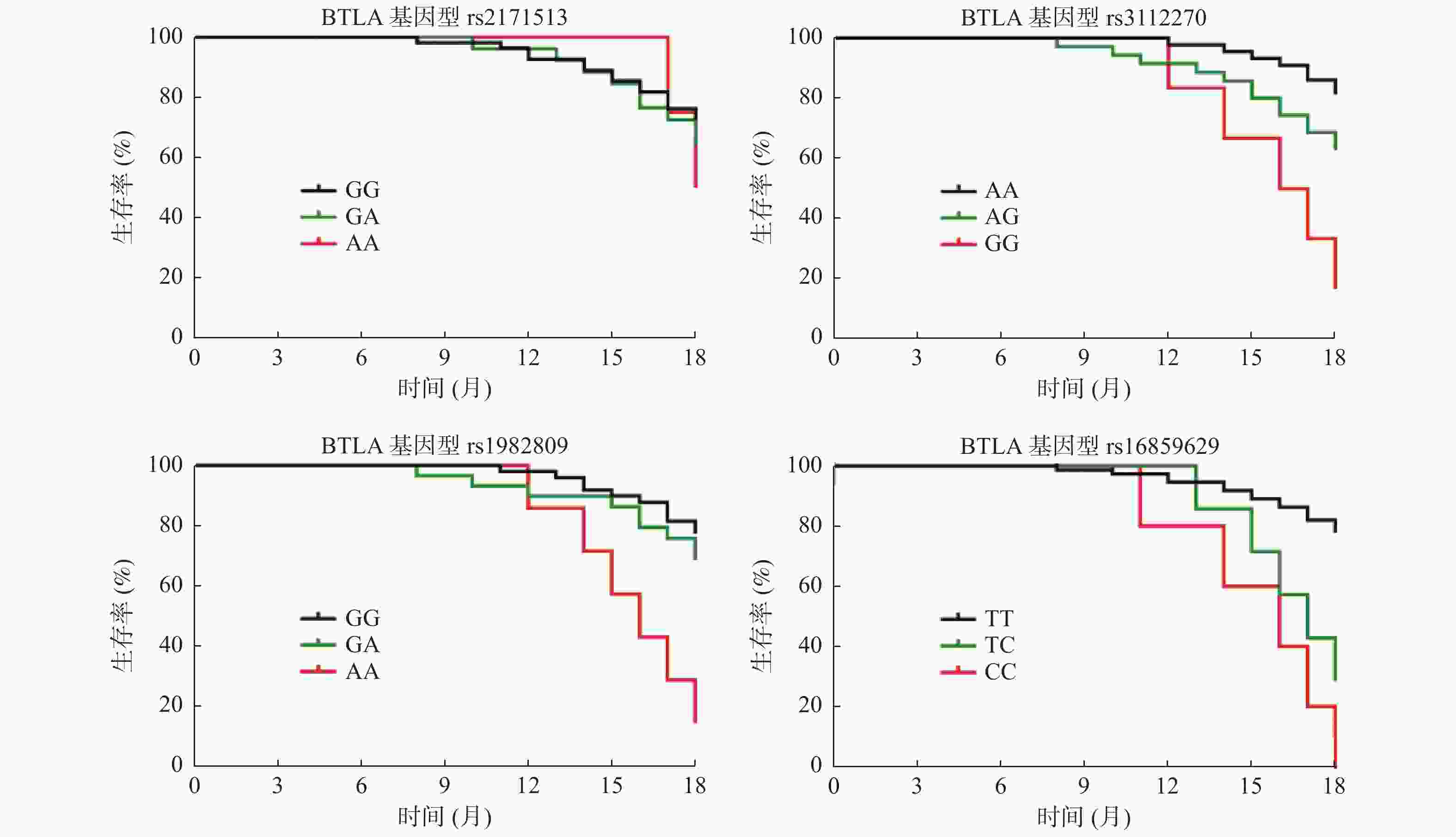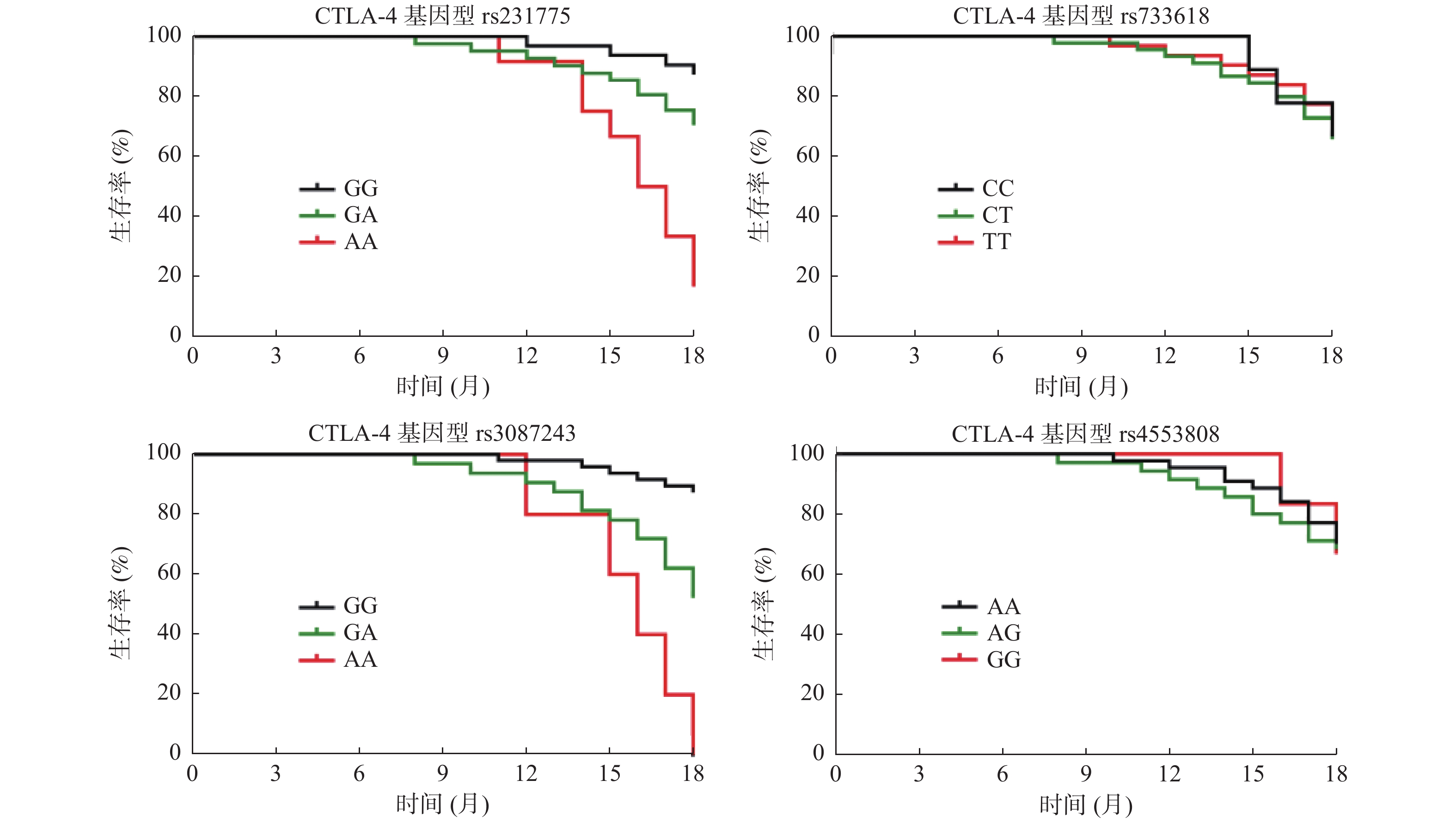The Analysis of the Correlation between BTLA,CTLA-4 Gene Polymorphisms and the Efficacy and Prognosis of TACE Combined Targeted Therapy for Liver Cancer
-
摘要:
目的 探讨B及T淋巴细胞弱化因子(BTLA)、细胞毒性T淋巴细胞抗原-4(CTLA-4)基因多态性与肝癌经动脉插管化疗栓塞(TACE)联合靶向治疗疗效及预后相关性。 方法 选取2021年1月至2021年12月期间南通大学附属医院介入放射科收治的新发85例肝癌患者作为研究对象,均行TACE联合靶向治疗,根据RECIST实体瘤疗效评价标准将患者分为治疗有效组(n = 58)、疾病进展组(n = 27),比较2组临床资料、BTLA、CTLA-4基因多态性,分析BTLA、CTLA-4基因多态性与疗效的相关性,并于治疗后18个月电话随访生存状况,对比不同基因型患者生存状况,分析其与生存预后的相关性。 结果 CTLA-4 rs231775、rs733618、rs3087243、rs4553808位点、BTLA rs2171513、rs3112270、rs1982809、rs16859629位点基因型均符合Hardy-Weinberg遗传平衡定律;治疗有效组BTLA rs3112270位点AG、GG基因型比例、rs1982809位点GA、AA比例、rs16859629位点CC基因型、CTLA-4 rs231775位点AA基因型比例、rs3087243位点GA、AA基因型低于疾病进展组,BTLA rs3112270位点AA基因型比例、rs1982809位点GG比例、rs16859629位点TT基因型、CTLA-4 rs231775位点GG基因型比例、rs3087243位点GG基因型高于疾病进展组(P < 0.05);单因素、多因素分析显示,BTLA rs3112270 A > G、rs1982809 G > A、rs16859629 T > C、CTLA-4 rs231775 A > G、rs3087243 G > A与疗效相关(P < 0.05);BTLA rs3112270位点AA、AG基因型患者18个月生存率高于GG基因型患者,rs1982809位点GG、GA基因型患者18个月生存率高于AA基因型患者,rs16859629位点TT基因型患者18个月生存率高于TC、CC基因型患者(P < 0.05);CTLA-4 rs231775位点GG、GA基因型患者18个月生存率高于AA基因型患者、rs3087243位点GG基因型18个月生存率高于GA、AA基因型患者(P < 0.05);单因素、多因素分析显示,BTLA rs3112270 A > G、rs1982809 G > A、rs16859629 T > C、CTLA-4 rs231775 A > G、rs3087243 G > A与生存预后相关(P < 0.05)。 结论 BTLA基因rs3112270、rs1982809、rs16859629、CTLA-4基因rs231775、rs3087243位点多态性与肝癌TACE联合靶向治疗疗效、预后密切相关,以期为预估TACE治疗提供参考。 Abstract:Objective To investigate the correlation between gene polymorphisms of B and T lymphocyte attenuator (BTLA) and cytotoxic T lymphocyte antigen-4 (CTLA-4) and the efficacy and prognosis of targeted therapy combined with transcatheter arterial chemoembolization (TACE) for liver cancer. Methods Eighty-five new hepatocellular carcinoma patients admitted to the Department of Interventional Radiology of Nantong University Hospital between 2021-01-01 and 2021-12-31 were selected for the study, and all of them were treated with TACE combined with targeted therapy. According to the RECIST solid tumor efficacy evaluation criteria, the patients were divided into the effective treatment group (n = 58) and the disease progression group (n = 27). The clinical data, BTLA, CTLA-4 gene polymorphisms between the 2 groups were compared and the correlation between BTLA, CTLA-4 gene polymorphisms and efficacy were analyzed, And follow-up survival status by phone at 18 months after the treatment was conducted to compare the survival status of patients with different genotypes, and analyze their correlation with survival prognosis. Results CTLA-4 rs231775, rs733618, rs3087243, rs4553808, BTLA and the genotypes of rs2171513, rs3112270, rs1982809 and rs16859629 all conformed to Hardy-Weinberg law of genetic balance. The BTLA rs3112270 AG, GG genotype ratio, rs1982809 GA, AA ratio, rs16859629 CC genotype, CTLA-4 rs231775 AA genotype ratio, rs3087243 GA, AA genotype ratio in the treatment effective group were all lower than those in the disease progression group, while the proportion of AA genotype at BTLA rs3112270, GG genotype at rs1982809, TT genotype at rs16859629, GG genotype at CTLA-4 rs231775, and GG genotype at rs3087243 were all higher than those in the disease progression group (P < 0.05); Univariate and multivariate analysis showed that BTLA rs3112270 A > G, rs1982809 G > A, rs16859629 T > C, CTLA-4 rs231775 A > G, rs3087243 G > A were all associated with the efficacy (P < 0.05); The 18 month survival rate of BTLA rs3112270 AA and AG genotype patients was higher than that of GG genotype patients, rs1982809 GG and GA genotype patients were higher than that of AA genotype patients, and rs16859629 TT genotype patients are higher than those of TC and CC genotype patients (P < 0.05); The 18 month survival rate of patients with CTLA-4 rs231775 GG and GA genotypes was higher than that of patients with AA genotypes, and the 18 month survival rate of GG genotype at rs3087243 was higher than that of patients with GA and AA genotypes (P < 0.05); Univariate and multivariate analysis showed that BTLA rs3112270 A > G, rs1982809 G > A, rs16859629 T > C, CTLA-4 rs231775 A > G, rs3087243 G > A were all associated with the survival prognosis (P < 0.05). Conclusion The polymorphisms of BTLA gene rs3112270, rs1982809, rs16859629, CTLA-4 gene rs231775, rs3087243 are closely related to the efficacy and prognosis of TACE combined with the targeted therapy for liver cancer and these will provide the reference for predicting TACE treatment. -
Key words:
- BTLA /
- CTLA-4 /
- Gene polymorphism /
- Liver cancer /
- TACE /
- Targeted therapy /
- Curative effect /
- Prognosis /
- Correlation
-
表 1 2组临床资料比较[n(%)/(
$\bar{x} \pm s$ )]Table 1. Comparison of clinical data between two groups [n(%)/(
$\bar{x} \pm s$ )]资料 治疗有效组(n = 58) 疾病进展组(n = 27) t/χ2 P 性别 0.552 0.457 男 43(74.14) 22(81.48) 女 15(25.86) 5(18.52) 年龄(岁) 52.13 ± 4.76 52.82 ± 5.11 0.608 0.545 BMI(kg/m2) 21.39 ± 1.25 21.18 ± 1.17 0.736 0.464 肿瘤最大径(cm) 3.82 ± 0.51 5.03 ± 0.74 8.777 < 0.001* 肿瘤数目(个) 2.75 ± 0.44 3.38 ± 0.53 5.753 < 0.001* Child-Pugh分级 5.776 0.001* A级 55(94.83) 20(74.07) B级 3(5.17) 7(25.93) BCLC分期 5.716 0.017* B期 18(31.03) 2(7.41) C期 40(68.97) 25(92.59) 肝外转移 5.963 0.015* 有 8(13.79) 10(37.04) 无 50(86.21) 17(62.96) 血管侵犯 4.713 0.030* 有 24(41.38) 18(66.67) 无 34(58.62) 9(33.33) *P < 0.05。 表 2 85例患者BTLA、CTLA-4基因型分布情况
Table 2. Distribution of BTLA and CTLA-4 genotypes in 85 patients
BTLA基因型 CTLA-4基因型 位点 n 频率 位点 n 频率 rs2171513 rs231775 GG 56 65.88 GG 31 36.47 GA 25 29.41 GA 42 49.41 AA 4 4.71 AA 12 14.12 rs3112270 rs733618 AA 45 52.94 CC 9 10.59 AG 34 40.00 CT 45 52.94 GG 6 7.06 TT 31 36.47 rs1982809 rs3087243 GG 48 56.47 GG 48 56.47 GA 30 35.29 GA 32 37.65 AA 7 8.24 AA 5 5.88 rs16859629 rs4553808 TT 72 84.71 AA 46 54.12 TC 8 9.41 AG 33 38.82 CC 5 5.88 GG 6 7.06 表 3 2组BTLA、CTLA-4基因型比较n(%)
Table 3. Comparison of BTLA and CTLA-4 genotypes between the two groups n(%)
BTLA基因型 CTLA-4基因型 项目 治疗有效组
(n = 58)疾病进展组(n = 27) u P 项目 治疗有效组
(n = 58)疾病进展组(n = 27) u P rs2171513 0.788 0.431 rs231775 2.920 0.004* GG 40(68.97) 16(59.26) GG 25(43.10) 6(22.22) GA 16(27.59) 9(33.33) GA 31(53.45) 11(40.74) AA 2(3.45) 2(7.41) AA 2(3.45) 10(37.04) rs3112270 4.638 < 0.001* rs733618 0.019 0.945 AA 41(70.69) 4(14.81) CC 6(10.34) 3(11.11) AG 17(29.31) 17(62.96) CT 31(53.45) 14(51.85) GG 0(0.00) 6(22.22) TT 21(36.21) 10(37.04) rs1982809 3.347 0.001* rs3087243 4.491 < 0.001* GG 40(68.97) 8(29.63) GG 43(74.14) 5(18.52) GA 17(29.31) 13(48.15) GA 15(25.86) 17(62.96) AA 1(1.72) 6(22.22) AA 0(0.00) 5(18.52) rs16859629 2.464 0.014* rs4553808 0.622 0.534 TT 51(87.93) 16(59.26) AA 33(56.90) 13(48.15) TC 7(12.07) 1(3.70) AG 21(36.21) 12(44.44) CC 0(0.00) 10(37.04) GG 4(6.90) 2(7.41) *P < 0.05。 表 4 BTLA、CTLA-4基因多态性与疗效的相关性
Table 4. Correlation between BTLA and CTLA-4 gene polymorphisms and therapeutic effect
自变量 单因素分析 Logistic多因素回归分析 OR 95%CI P OR 95%CI P BTLA基因 rs2171513G > A 1.211 0.417~3.519 0.417 1.740 0.523~5.791 0.518 rs3112270A > G 5.396 1.794~16.228 < 0.001* 6.252 2.041~19.153 < 0.001* rs1982809G > A 6.602 2.061~21.147 < 0.001* 7.699 2.274~26.065 < 0.001* rs16859629T > C 4.675 1.537~14.220 < 0.001* 5.441 1.882~15.730 < 0.001* CTLA-4基因 ~ ~ rs231775A > G 5.828 1.809~18.773 < 0.001* 5.650 2.005~15.924 < 0.001* rs733618C > T 0.978 0.325~2.941 0.623 1.122 0.246~5.113 0.264 rs3087243G > A 6.037 2.260~16.128 < 0.001* 6.486 2.175~19.340 < 0.001* rs4553808A > G 1.240 0.249~6.177 0.329 1.065 0.196~5.782 0.187 *P < 0.05。 表 5 不同BTLA、CTLA-4基因型患者生存预后状况比较
Table 5. Comparison of survival and prognosis of patients with different BTLA and CTLA-4 genotypes
BTLA基因型 CTLA-4基因型 项目 n 生存率 χ2 P 项目 n 生存率 χ2 P rs2171513 1.115 0.543 rs231775 19.502 < 0.001* GG 53 71.70(38/53) GG 30 86.67(26/30) GA 25 64.00(16/25) GA 40 70.00(28/40) AA 4 50.00(2/4) AA 12 16.67(2/12) rs3112270 11.163 0.004* rs733618 0.563 0.755 AA 42 80.95(34/42) CC 9 66.67(6/9) AG 34 61.76(21/34) CT 43 65.12(28/43) GG 6 16.67(1/6) TT 30 73.33(22/30) rs1982809 10.928 0.004* rs3087243 22.152 < 0.001* GG 47 76.60(36/47) GG 46 86.96(40/46) GA 28 67.86(19/28) GA 31 51.61(16/31) AA 7 14.29(1/7) AA 5 0.00(0/5) rs16859629 18.402 < 0.001* rs4553808 0.091 0.956 TT 70 77.14(54/70) AA 43 69.77(30/43) TC 7 28.57(2/7) AG 33 66.67(22/33) CC 5 0.00(0/5) GG 6 66.67(4/6) *P < 0.05。 表 6 BTLA、CTLA-4基因多态性与生存预后的相关性
Table 6. Correlation between BTLA and CTLA-4 gene polymorphism and survival prognosis
自变量 单因素分析 Logistic多因素回归分析 HR 95%CI P HR 95%CI P BTLA基因 rs2171513G > A 1.156 0.187~7.144 0.095 0.902 0.165~4.936 0.236 rs3112270A > G 4.336 1.509~12.457 < 0.001* 4.439 1.441~13.672 < 0.001* rs1982809G > A 5.587 1.914~16.308 < 0.001* 5.123 1.659~15.820 < 0.001* rs16859629T > C 6.620 2.069~21.182 < 0.001* 7.262 2.183~24.159 < 0.001* CTLA-4基因 rs231775A > G 6.588 2.397~18.105 < 0.001* 6.058 2.116~17.342 < 0.001* rs733618C > T 1.157 0.201~6.665 0.102 0.942 0.188~4.724 0.221 rs3087243G > A 7.906 2.522~24.781 < 0.001* 6.642 2.183~20.210 < 0.001* rs4553808A > G 0.907 0.194~4.238 0.174 0.834 0.176~3.952 0.279 *P < 0.05。 -
[1] Xia C,Dong X,Li H,et al. Cancer statistics in China and United States,2022: Profiles,trends,and determinants[J]. Chin Med J (Engl),2022,135(5):584-590. doi: 10.1097/CM9.0000000000002108 [2] Sung H,Ferlay J,Siegel R L,et al. Global cancer statistics 2020: GLOBOCAN estimates of incidence and mortality worldwide for 36 cancers in 185 countries[J]. CA Cancer J Clin,2021,71(3):209-249. doi: 10.3322/caac.21660 [3] Yu Y,Fu J,Xia P,et al. A systematic review and meta-analysis on the efficacy and safety of transcatheter arterial chemoembolization combined with radiofrequency ablation in the treatment of primary liver cancer[J]. Transl Cancer Res,2022,11(5):1297-1308. doi: 10.21037/tcr-22-816 [4] Shao L,Wang X,Yu Y,et al. Comparative analysis of the efficacy and accuracy of magnetic resonance imaging (MRI) and contrast-enhanced CT for residual and new lesions after transcatheter arterial chemoembolization (TACE) in patients with primary liver cancer[J]. Transl Cancer Res,2021,10(8):3739-3747. doi: 10.21037/tcr-21-831 [5] Zhong Y,Xu F,Wu J,et al. Application of next generation sequencing in laboratory medicine[J]. Ann Lab Med,2021,41(1):25-43. doi: 10.3343/alm.2021.41.1.25 [6] Chen J,Wang J,Liu R,et al. The correlation of BTLA rs1982809 polymorphism with cancer susceptibility: A meta-analysis of 8634 participators[J]. Medicine (Baltimore),2022,101(31):e29610. [7] Chen J,Kang S,Wu J,et al. CTLA-4 polymorphism contributes to the genetic susceptibility of epithelial ovarian cancer[J]. J Obstet Gynaecol Res,2022,48(5):1240-1247. doi: 10.1111/jog.15186 [8] 《原发性肝癌诊疗规范(2019年版)》编写专家委员会. 原发性肝癌诊疗规范(2019年版)[J]. 中国临床医学,2020,27(1):140-156. [9] 杨学宁,吴一龙. 实体瘤治疗疗效评价标准-RECIST[J]. 循证医学,2004,4(2):85-90,111. doi: 10.3969/j.issn.1671-5144.2004.02.012 [10] Zhang C,Dai Y H,Lian S F,et al. Efficacy of transcatheter arterial chemoembolization using pirarubicin-loaded microspheres combined with lobaplatin for primary liver cancer[J]. World J Clin Cases,2022,10(27):9650-9656. doi: 10.12998/wjcc.v10.i27.9650 [11] Huh J,Kim B,Lee J H,et al. Added value of CT arterial subtraction images in liver imaging reporting and data system treatment response categorization for transcatheter arterial chemoembolization-treated hepatocellular carcinoma[J]. Invest Radiol,2021,56(2):109-116. doi: 10.1097/RLI.0000000000000714 [12] Vosshenrich J,Zech C J,Heye T,et al. Response prediction of hepatocellular carcinoma undergoing transcatheter arterial chemoembolization: Unlocking the potential of CT texture analysis through nested decision tree models[J]. Eur Radiol,2021,31(6):4367-4376. doi: 10.1007/s00330-020-07511-3 [13] Zhang H,Fu L. The role of ALDH2 in tumorigenesis and tumor progression: Targeting ALDH2 as a potential cancer treatment[J]. Acta Pharm Sin B,2021,11(6):1400-1411. doi: 10.1016/j.apsb.2021.02.008 [14] Wang Y,Xia X B,Tang H Z,et al. Association of T2285C polymorphism in PARP1 gene coding region with its expression,activity and NSCLC risk along with prognosis[J]. Mutagenesis,2021,36(4):281-293. doi: 10.1093/mutage/geab022 [15] Herrero Rivera D,Vacas C G,Kovandzic L M,et al. Single-nucleotide polymorphism associations with efficacy and toxicity in metastatic castration-resistant prostate cancer treated with cabazitaxel[J]. Pharmacogenomics,2022,23(11):627-638. doi: 10.2217/pgs-2022-0023 [16] 刘绍灵,彭国璇,邓进. BTLA基因与炎症免疫调控研究进展[J]. 创伤外科杂志,2017,19(7):555-557. doi: 10.3969/j.issn.1009-4237.2017.07.025 [17] Kraehenbuehl L,Weng C H,Eghbali S,et al. Enhancing immunotherapy in cancer by targeting emerging immunomodulatory pathways[J]. Nat Rev Clin Oncol,2022,19(1):37-50. doi: 10.1038/s41571-021-00552-7 [18] Khadhraoui C,Kaabachi W,Tritar F,et al. Association of BTLA rs1982809 polymorphism with lung cancer risk in Tunisian population[J]. Int J Immunogenet,2020,47(6):554-562. doi: 10.1111/iji.12491 [19] Fu Z,Li D,Jiang W,et al. Association of BTLA gene polymorphisms with the risk of malignant breast cancer in Chinese women of Heilongjiang province[J]. Breast Cancer Res Treat,2010,120(1):195-202. doi: 10.1007/s10549-009-0462-6 [20] 王居巳. BTLA基因多态性在非小细胞肺癌易感性方面的关联性分析[D]. 福州: 福建医科大学硕士学位论文, 2021. [21] Ui A,Chiba N,Yasui A. Relationship among DNA double-strand break (DSB),DSB repair,and transcription prevents genome instability and cancer[J]. Cancer Sci,2020,111(5):1443-1451. doi: 10.1111/cas.14404 [22] Zhang H,Dai Z,Wu W,et al. Regulatory mechanisms of immune checkpoints PD-L1 and CTLA-4 in cancer[J]. J Exp Clin Cancer Res,2021,40(1):184. doi: 10.1186/s13046-021-01987-7 [23] 刘琦,赵灵燕,程佳颖,等. CTLA-4基因多态性与肾癌易感性的相关性研究[J]. 实用癌症杂志,2021,36(3):497-500. doi: 10.3969/j.issn.1001-5930.2021.03.039 [24] Najafi A,Alizadeh-Navaei R,Rahimi S,et al. Genetic polymorphisms of cytotoxic T-lymphocyte antigen 4 (CTLA-4) and clinical outcomes post-allogeneic hematopoietic stem cell transplantation: A systematic review and meta-analysis[J]. Clin Transplant,2021,35(8):e14364. doi: 10.1111/ctr.14364 [25] Liu X,Swen J J,Diekstra M H M,et al. A genetic polymorphism in CTLA-4 is associated with overall survival in sunitinib-treated patients with clear cell metastatic renal cell carcinoma[J]. Clin Cancer Res,2018,24(10):2350-2356. doi: 10.1158/1078-0432.CCR-17-2815 [26] Qin X Y,Lu J,Li G X,et al. CTLA-4 polymorphisms are associated with treatment outcomes of patients with multiple myeloma receiving bortezomib-based regimens[J]. Ann Hematol,2018,97(3):485-495. doi: 10.1007/s00277-017-3203-7 -






 下载:
下载:





